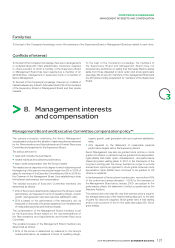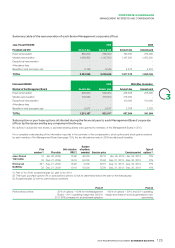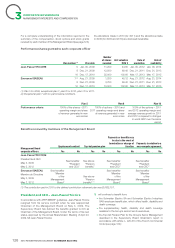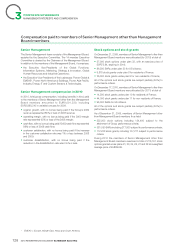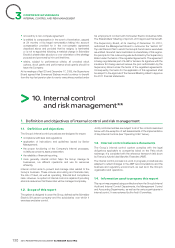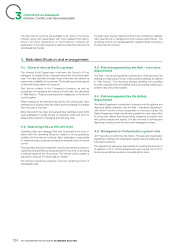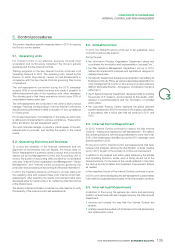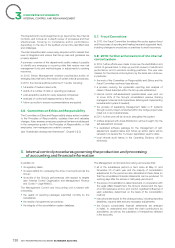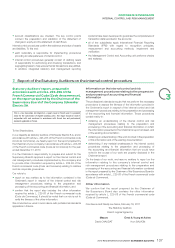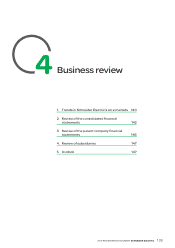APC 2010 Annual Report Download - page 133
Download and view the complete annual report
Please find page 133 of the 2010 APC annual report below. You can navigate through the pages in the report by either clicking on the pages listed below, or by using the keyword search tool below to find specific information within the annual report.
CORPORATE GOVERNANCE
3
INTERNAL CONTROL ANDRISKMANAGEMENT
2. Internal control organisation and management: key participants
In 2010, the Group’s organisational chart rests on Senior
Management, of Global Functions, of Operating Divisions; defi ned
in terms of businesses, geographical location, logistical or industrial
responsibility.
The Group’s corporate governance bodies supervise the
development of the internal control and risk management systems.
The Audit Committee has particular responsibility for monitoring the
system’s effectiveness (see Committees of the Supervisory Board,
Chapter 3 § 4).
Each manager is responsible for monitoring internal control in his
or her area, at the different levels of the organisation, as are all key
internal control participants, in accordance with the tasks described
below.
2.1. Senior Management
(See Committees of the Supervisory Board, Chapter 3 § 4).
Senior Management is responsible for designing and leading the
overall internal control system, with support from all key participants
and notably the Internal Audit and Group’s Internal Control
Departments.
It also monitors the Group’s performance, during quarterly reviews
with the Operating Divisions and Global Functions. These reviews
cover business trends, action plans, current results and forecasts
for the quarters ahead. Similar reviews are carried out at different
levels of the Group prior to Senior Management’s quarterly review.
2.2. Internal Audit Department
The Internal Audit Department reports to Senior Management. It
had an average staff of 12 people in 2010. The internal auditors are
responsible for ensuring that, at the level of each unit:
•risks are appropriately identifi ed and managed;
•signifi cant fi nancial, management and operating information is
accurate, reliable and timely;
•employees’ actions are in compliance with the Group’s policies,
standards, procedures and the applicable laws and regulations;
•instructions issued by Senior Management are effectively applied;
•resources are acquired economically, used effi ciently and
protected adequately.
Annual internal audit plans are drawn up based on risk and control
concerns identifi ed by Senior Management, taking into account the
results of past audits, the work performed by the external auditors
and the results of internal control self-assessments returned by the
units. When necessary, the audit plan is adjusted during the year to
include special requests from Senior Management. These missions,
which are not included in the initial audit plan, help the Group detect
potential cases of fraud.
The internal audit process is described in Section 5 below.
After each internal audit, a report is issued setting out the auditors’
fi ndings and recommendations. Copies of the report are given to
the head of the audited entity, Senior Management and the Audit
Committee.
The external auditors also have access to the reports.
Measures are taken to monitor implementation of recommendations
and specifi c audits are conducted if necessary.
2.3. Internal Control Department
The Internal Control Department, which was created in 2008 and
reports to the Internal Audit Department, is responsible for:
•defi ning and updating the list of Key Internal Controls in close
cooperation with the Global Functions and in line with the
recommendation of the AMF reference framework;
•setting up and leading a network of internal controllers in the
Operating Divisions, with responsibility for defi ning Key Internal
Controls and ensuring their use in the operating units within
their scope – notably through training sessions and annual self-
assessments;
•analysing and critically reviewing the results of these self-
assessments to identify areas that require an action plan at the
Group, Operating Division or Global Function level;
•leading the Internal Control Committee, comprising internal
controllers from the Operating Divisions, as well as internal control
correspondents from the Global Functions. The Committee
members work to improve internal control and adapt procedures
in light of the results of self-assessments and changes in the
business environment or organisation.
2.4. Finance and Control – Legal Affairs
Departement
The Finance and Control – Legal Affairs Department is actively
involved in organising control and ensuring compliance with
procedures.
Within the department, the Management Control and Accounting
unit plays a key role in the internal control system by:
•drafting and updating instructions designed to ensure that
statutory and management accounting practices are consistent
throughout the Group and compliant with applicable regulations;
•organising period-end closing procedures;
•analysing performance and tracking the achievement of targets
assigned to the operating units.
The Management Control and Accounting unit is responsible for:
•the proper application of Group accounting principles and
policies;
•the integrity of the consolidation system database;
•the quality of accounting processes and data;
•training for fi nance staff in the form of specifi c seminars;
2010 REGISTRATION DOCUMENT SCHNEIDER ELECTRIC 131


